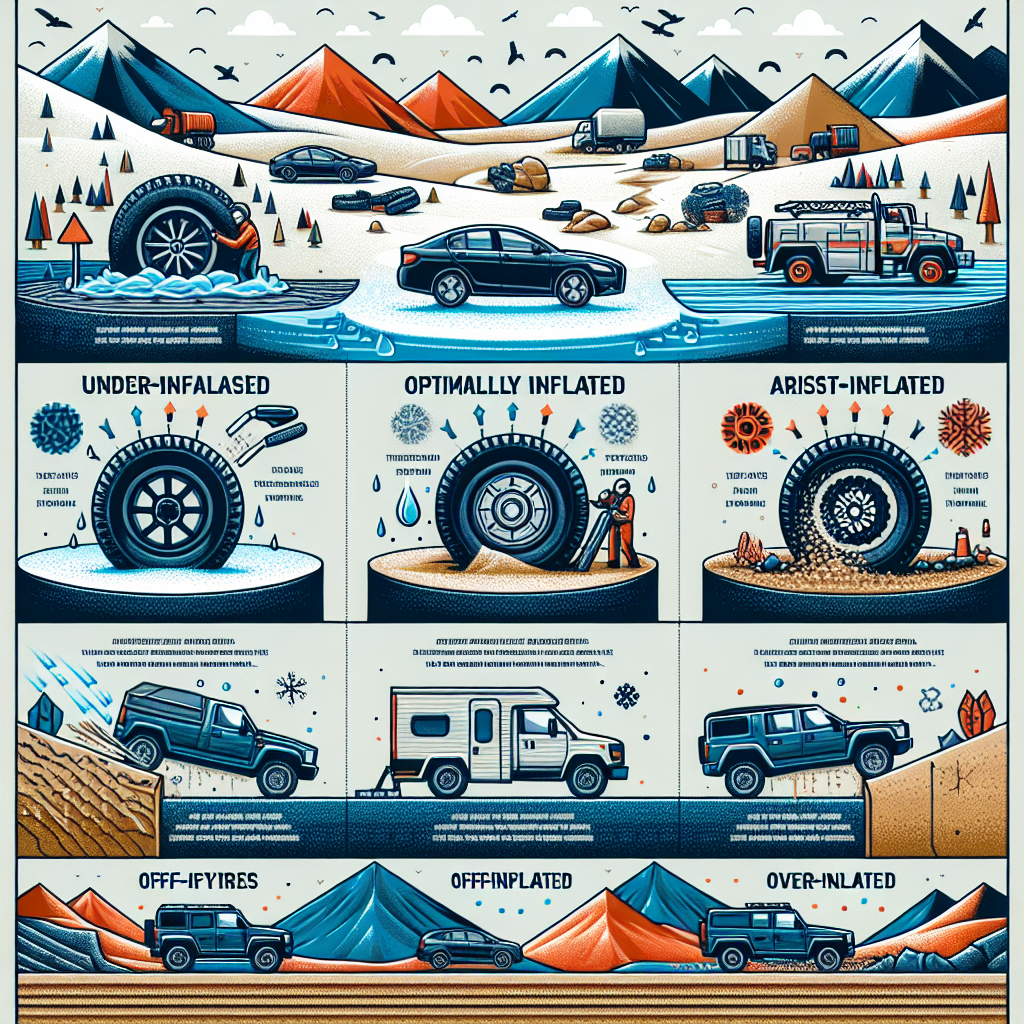Have you ever wondered how tire pressure can impact the traction of your vehicle on various surfaces? Maintaining the correct tire pressure is not only crucial for your safety but also plays a significant role in the overall performance of your vehicle. Whether you’re driving on wet roads, snow-covered terrain, or even off-road trails, the amount of air in your tires can greatly affect how well your vehicle maintains traction and handles different types of surfaces. In this article, we will explore the relationship between tire pressure and traction, and discover how effectively managing tire pressure can enhance your driving experience.
Explaining Tire Pressure
Definition of tire pressure
Tire pressure refers to the amount of air inside a tire, measured in pounds per square inch (psi). It is a crucial aspect of maintaining optimal performance, safety, and longevity of your vehicle’s tires. Each vehicle has a recommended tire pressure that is specified by the manufacturer, and it is important to ensure that your tires are inflated to the correct pressure.
Importance of proper tire pressure
Proper tire pressure is of utmost importance for several reasons. Firstly, it ensures that your vehicle handles and performs at its best on various surfaces. Secondly, it promotes better fuel efficiency, as underinflated or overinflated tires can lead to increased rolling resistance and higher fuel consumption. Lastly, maintaining the correct tire pressure prolongs the lifespan of your tires, reducing the risk of premature wear and tire failure.
Tire Pressure and Traction
Connection between tire pressure and traction
Tire pressure plays a significant role in the traction capabilities of your tires. The amount of contact your tires have with the road, also known as the contact patch, is directly affected by tire pressure. The larger the contact patch, the more traction your tires can generate.
Effect of tire pressure on contact patch
The contact patch refers to the portion of the tire that is in direct contact with the road surface. When the tire pressure is too low, the contact patch increases, leading to a larger footprint on the road. This can result in improved traction, especially in certain conditions like snow or sand. On the other hand, if the tire pressure is too high, the contact patch decreases, which can lead to reduced traction and compromised handling.
Relationship between tire pressure and grip
Proper tire pressure is crucial for optimal grip on different surfaces. When the tire pressure is within the manufacturer’s recommended range, the tire’s tread and compound can effectively engage with the road, maximizing grip. This is particularly important during cornering, braking, and accelerating, where the traction capabilities of the tires greatly influence the vehicle’s overall performance and stability.

Tire Pressure on Wet Surfaces
Importance of proper tire pressure on wet surfaces
Maintaining the correct tire pressure is even more critical when driving on wet surfaces. Wet roads can be treacherous, and proper tire pressure enhances your safety by improving traction and reducing the risk of hydroplaning.
Increased risk of hydroplaning with incorrect tire pressure
Hydroplaning occurs when a layer of water builds up between the tires and the road surface, causing a loss of traction. Incorrect tire pressure, particularly underinflation, can increase the likelihood of hydroplaning. When the tire’s contact patch is larger due to underinflation, it creates a higher risk of losing traction and control on wet roads.
Optimal tire pressure for wet traction
To ensure optimal traction on wet surfaces, it is essential to maintain the recommended tire pressure specified by the vehicle manufacturer. The correct tire pressure helps to maintain an appropriate contact patch, allowing the tires to effectively displace water and maintain grip. Regularly checking and adjusting tire pressure is crucial, especially before embarking on long journeys or when encountering varying weather conditions.
Tire Pressure on Dry Surfaces
Influence of tire pressure on dry surface traction
While proper tire pressure is crucial for wet surface traction, it is equally important on dry surfaces. Optimal tire pressure enhances grip, stability, and overall performance when driving on dry roads.
Tire contact patch on dry surfaces
On dry surfaces, the contact patch plays a significant role in achieving maximum traction. When the tire pressure is within the recommended range, the contact patch is optimized, allowing the tire’s tread pattern to maintain effective contact with the road surface. This results in improved grip, better cornering capability, and shorter stopping distances.
Ideal tire pressure for dry traction
To ensure optimal traction on dry surfaces, it is advisable to maintain the recommended tire pressure specified by the vehicle manufacturer. This allows the tires to perform at their best, delivering the desired level of grip, stability, and overall handling. Regularly monitoring tire pressure and adjusting it as necessary will help maintain the desired level of performance on dry roads.

Tire Pressure on Snow/Icy Surfaces
Effect of tire pressure on snow/ice traction
Tire pressure has a significant impact on traction when driving on snow or icy surfaces. Adjusting your tire pressure according to the specific conditions can greatly enhance your vehicle’s maneuverability and safety.
Decreased maneuverability with incorrect tire pressure
When the tire pressure is too high on snow or icy surfaces, the tires can have limited grip and reduced flexibility, resulting in decreased maneuverability. Conversely, if the tire pressure is too low, the tires can create excessive rolling resistance, sinking into the snow or slush, and compromising handling.
Finding the right tire pressure for snow/ice surfaces
To optimize traction and maneuverability on snow and ice, it is recommended to slightly decrease tire pressure within the vehicle manufacturer’s guidelines. This allows the tires to better conform to the uneven surface, increasing the effective contact area and improving traction. However, it is crucial to strike a balance and not go below the recommended pressure range, as excessively low tire pressure can have adverse effects on handling and tire longevity.
Tire Pressure on Sand/Mud Surfaces
Challenges of driving on sand/mud
Driving on sand or mud surfaces presents unique challenges that require appropriate tire pressure adjustments. The soft, loose terrain demands specific considerations to maintain traction and prevent getting stuck.
Tire pressure’s impact on sand/mud traction
Lowering the tire pressure when driving on sand or mud surfaces helps increase the tire’s footprint and improves flotation. By reducing the tire pressure, the tire can spread out and distribute the vehicle’s weight over a larger area, preventing excessive sinking and improving traction.
Determining optimal tire pressure on sand/mud
While the ideal tire pressure for sand and mud may vary depending on factors like vehicle weight and specific conditions, it is generally recommended to decrease tire pressure significantly. This allows the tire to deform and create a larger footprint, effectively bulldozing through the sand or mud while maintaining sufficient traction. However, it is crucial to avoid excessively low tire pressure, which can lead to tire damage or jeopardize the stability and control of the vehicle.

Tire Pressure on Gravel/Dirt Surfaces
Importance of tire pressure for gravel/dirt driving
Driving on gravel and dirt surfaces requires attention to tire pressure to ensure optimal performance and safety. Adjusting tire pressure can significantly enhance grip and stability on these rough terrains.
Enhancing grip with proper tire pressure
By lowering tire pressure when driving on gravel or dirt, the tire’s surface area in contact with the ground increases, improving traction. This larger contact patch helps the tread maintain better bite, prevent wheel spinning, and enhance overall control and stability.
Recommended tire pressure range for gravel/dirt surfaces
While the specific optimal tire pressure for gravel and dirt surfaces may vary depending on factors like tire type and vehicle weight, it is generally recommended to decrease tire pressure within the manufacturer’s guidelines. This adjustment allows the tire to better conform to the uneven surface, reducing the risk of losing traction and providing enhanced stability during off-road driving.
Tire Pressure and Vehicle Load
Effect of vehicle load on tire pressure
Vehicle load has a direct impact on tire pressure. As the weight carried by the vehicle increases, the tire pressure must be adjusted to ensure optimal performance and safety.
Adjusting tire pressure for heavier loads
When carrying heavier loads, it is crucial to increase the tire pressure to compensate for the additional weight. The increased tire pressure helps maintain the appropriate contact patch and prevents excessive tire flexing, which can lead to overheating, reduced handling, and potential tire failure.
Ensuring safety with correct tire pressure
Maintaining the correct tire pressure for the specific vehicle load is essential to ensure safety while driving. It is important to check the manufacturer’s guidelines, consult the vehicle’s manual, or seek professional advice to determine the appropriate tire pressure for different loading conditions.

Tire Pressure Maintenance
Regular tire pressure checks
To ensure optimal traction and performance, regular tire pressure checks are vital. Tire pressure can fluctuate due to various factors, including temperature changes and natural air leakage, so it is crucial to monitor and adjust it accordingly.
Factors affecting tire pressure
Several factors can impact tire pressure over time. Temperature fluctuations, both seasonal and daily, can cause the air inside the tire to expand or contract, affecting the tire pressure. Additionally, slow leaks or gradual air loss can occur due to wear, punctures, or valve issues, leading to gradual pressure reduction.
Proper inflation techniques
When inflating tires, it is important to use a reliable tire pressure gauge and follow the manufacturer’s recommended guidelines. Overinflating or underinflating tires can lead to decreased performance, compromised safety, and increased tire wear. Additionally, it is advisable to check tire pressure when the tires are cold, as tire pressure increases as the tires heat up during driving.
Conclusion
The critical role of tire pressure in traction
Tire pressure plays a crucial role in determining the traction capabilities of your vehicle on various surfaces. Whether driving on wet roads, dry surfaces, snow, sand, gravel, or mud, maintaining the correct tire pressure is vital for optimal grip, stability, maneuverability, and overall safety.
Benefits of maintaining correct tire pressure on different surfaces
By maintaining the recommended tire pressure, you can maximize your vehicle’s performance and safety. Proper tire pressure ensures a suitable contact patch, allowing the tread to effectively engage with the road surface, improving traction. Whether on wet or dry surfaces, during winter or off-road adventures, maintaining the correct tire pressure enhances your driving experience and minimizes the risk of accidents or tire-related issues. Regularly checking and adjusting tire pressure will help you make the most of your tires and ensure a smooth and safe journey.

